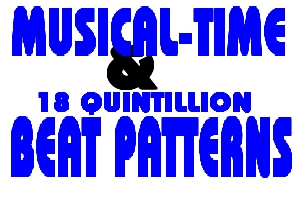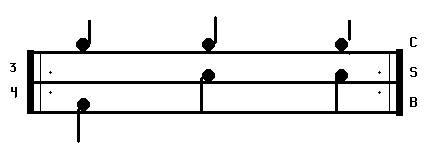|
Bill Powelson's,
MUSICAL TIME & RHYTHMS:

"FINITE TO INFINITY"
Waltz

What is a Waltz?
The Waltz beat gets its name from a dance, based on three steps and a three-count measure. According to Webster, the term originated from Old High German walzan, meaning to turn or roll. It first appeared in 1781. The dictionaries and encyclopedias all seem to insinuate 3/4 time only. We will see in a moment that many variations of the Waltz dance beat may be written in any number of interesting time signatures. We will begin with the slower rhythms and move up to the quick tempo beats.
NOTICE: When it seems that musical symbols (rests) may confuse beginning students, I will avoid using them.
16th note 3/4 Waltz: This rhythm hasn't really had its day in the sun. You will not hear many
songs that use it. I say it is waiting for the right song or songs. After studying
Permutation theory you will be able to visualize at least 16,777,216 variation possibilities within
this solitary form of Waltz. How many songs are you familiar with that use it? Go get 'em,
songwriters!
  Hear the Basic 16th WALTZ Beat Hear the Basic 16th WALTZ Beat
8th triplet 3/4 Waltz or 9/8 Waltz:
This has become a very popular form of Waltz. You will hear
this pattern used often in top 40, contemporary and country & western music styles. When played at a
comfortable tempo, it can take some drudgery away from playing the really boring songs. This beat contains
262,144 variations, not including syncopations. We need not write it exclusively in 3/4 time.
I am showing two examples below, to help illustrate that point.
8th triplet 3/4 Waltz:
. . . SAY "1 an a 2 an a 3 an a"
  Hear the Basic 8TH TRIPLET WALTZ
Beat Hear the Basic 8TH TRIPLET WALTZ
Beat
The 9/8 version possesses exactly the same permutations and is played the same. It is the same beat pattern
and we could write it several other ways as well. Since we are now counting 8th-notes, (not triplets), we . . .
. . . SAY " 1 2 3 4 5 6 7 8 9 "
  Hear the Basic 9/8 WALTZ Beat Hear the Basic 9/8 WALTZ Beat
8th note 3/4 Waltz: This modification of 3/4 time may not seem especially
exciting at first but with practice you will discover that it is a close cousin to
the ever popular 8th 4/4 'rock' beat that has dominated the music scene for so many years. You will also quickly
discover that it has inherited much of the same 'funk' potential as cousin 'Rocko'. After you gain a feel for
8th 3/4 you will find yourself jamming with variations, syncopations and fills on a new level. From that
point, all you will need is a band, innovative enough to create lyrics and music to fit the beat. We
may squeeze up to 160,000 syncopated variations from this pattern.
  Hear the Basic 8th WALTZ Beat Hear the Basic 8th WALTZ Beat
If you want something a little tougher, try the syncopated variation below. Also, experiment with a few similar
examples of your own.
  Hear the Syncopated WALTZ Beat Hear the Syncopated WALTZ Beat
Shuffle 3/4 Waltz: There are 8th rests in this one that we can't live without.
Count:"1 an a 2 an a 3 an a". Do not strike the cymbal as you say "an". Like Swing/Shuffle 4/4 it may take a
while to get this one perfect. Don't worry about it if you are having trouble. Sometimes it will require
just the right song before it will feel natural. Polish will come with time and experience, so be patient.
Shuffle Waltzes are more prevalent in Country & Western music styles. We may write this pattern several ways,
including triplet 3/4 or 9/8. Theoretically it exists with the same number of variation possibilities, no matter
how we choose to write it.
  Hear the Basic SHUFFLE WALTZ Beat Hear the Basic SHUFFLE WALTZ Beat
Quarter note 3/4 Waltz: Quarter note Waltz is most often used with fast waltz tunes. It is easy
to play but a bit of a bore!  Hear the
Basic 4th WALTZ Beat Hear the
Basic 4th WALTZ Beat
There is still much more . . . Yes, I am afraid there is a whole lot more but then it may
be two or three centuries before any of it will be of any practical use. For example, if you are up on
your note values. Some modifications I have excluded are:
- 16th triplet 3/4 contains a whopping 6.87 billion permutations.
- 32nd 3/4 contains 2.81474977e+14 variations. This pattern contains some interesting 'disco' possibilities
too. By 'disco' I am referring to playing a two-handed roll on the hi-hat while slipping to the snare
on the counts of 2 and 3.
- 64th 3/4. . . .forget it!
NEXT LESSON:
TIME-SIGNATURES: (1/1 to 64/64.)
NOW . . . we're
ready to explode the big bomb.
Visit the time-signature lesson and study it with the objective
of implanting every possible beat and/or every beat variation in the
known musical universe, into your own mind . . . all in one sitting.
The Drum Lesson Menu

Copyright Bill Powelson
1985-2xxx all rights
reserved.
|